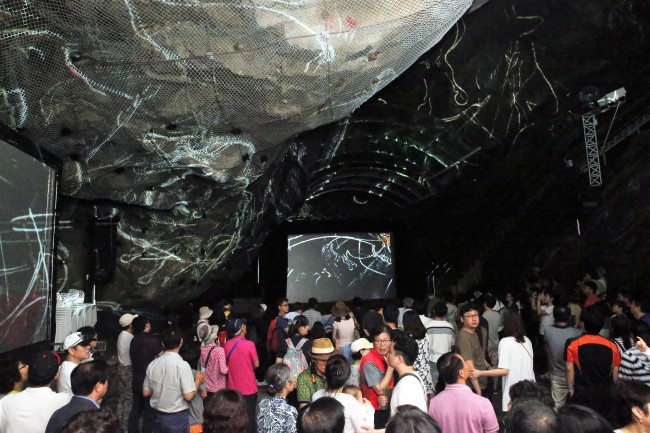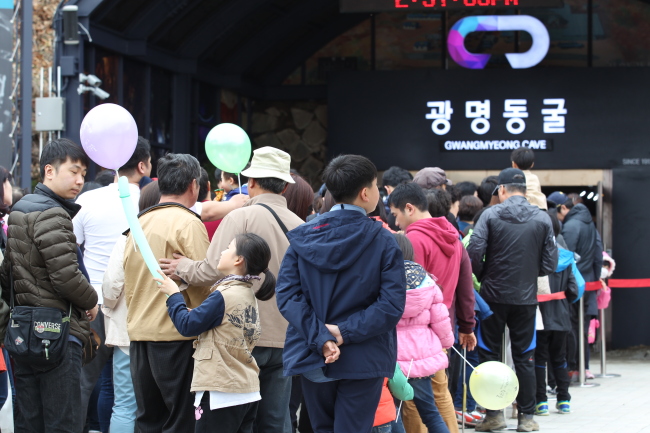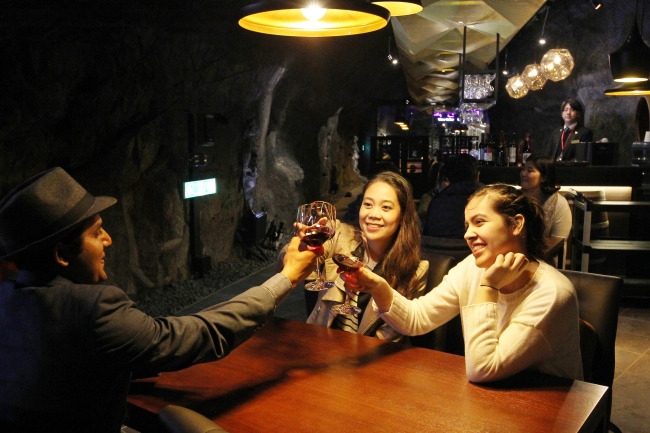Gwangmyeong Cave wraps up Lascaux exhibition, looks to next chapter
More than 1 million visit went to Gwangmyeong Cave this year, making it a new tourist hot spot
By 줄리 잭슨 (Julie Jackson)Published : Sept. 4, 2016 - 17:21
For the first time in Asia, France’s cherished Lascaux Paleolithic cave paintings found a temporary home inside Korea’s Gwangmyeong Cave.
In celebration of the 130th anniversary of diplomatic ties between Korea and France, the Lascaux International Exhibition made its way here. The commemorative diplomatic project allowed Gwangmyeong Cave -- the country’s latest tourist hot spot -- to host the Lascaux International Exhibition from April through Sept. 4.
The world-famous Lascaux cave paintings dating back some 20,000 years were discovered in 1940 near Dordogne in southwestern France. The paintings -- depicting a variety of animals -- were eventually inscribed on the UNESCO World Heritage list in 1979.
In celebration of the 130th anniversary of diplomatic ties between Korea and France, the Lascaux International Exhibition made its way here. The commemorative diplomatic project allowed Gwangmyeong Cave -- the country’s latest tourist hot spot -- to host the Lascaux International Exhibition from April through Sept. 4.
The world-famous Lascaux cave paintings dating back some 20,000 years were discovered in 1940 near Dordogne in southwestern France. The paintings -- depicting a variety of animals -- were eventually inscribed on the UNESCO World Heritage list in 1979.

The Lascaux International Exhibition started in 2012. It displayed various life-size mockups of the Lascaux cave paintings across the US, Canada, Belgium and Switzerland, before finally finding its way to Korea. The paintings are soon slated to move on to Japan following the conclusion of the Gwangmyeong Cave exhibition.
The historic exhibition of Lascaux, Gwangmyeong Cave in Gyeonggi Province has put the city of Gwangmyeong in the public spotlight -- both locally and internationally -- like never before.
Gwangmyeong Mayor Yang Gi-dae had stated that The Lascaux International Exhibition would help propel both the Gwangmyeong Cave and the city of Gwangmyeong to become one of the peninsula’s must-visit travel destinations.

Since opening its doors in 2011, more than 3 million people have visited Gwangmyeong Cave. An admission fees were put in place last April, but this did not stop people from coming, with the tourist attraction seeing over 2 million people so far. The site attracted over a million visitors this year alone.
Sparking fascination among locals and outsiders alike, the cave has seen a total of some 40,000 foreign visitors since last August.
“Although admission fees for Gwangmyeong Cave have been introduced, the city of Gwangmyeong still managed to attract more than 900,000 visitors, earning roughly 4 billion won in nontaxable income,” according to an official a statement from Gwangmyeong City.
“We’ve created some 200 jobs in a period of nine months. Just this year, the city has created nearly 400 employment opportunities and has seen approximately 7 billion won ($6.27 million) in nontaxable income through the cave alone.”
Although the Lascaux exhibition has come to an end, the cave-turned-theme park still offers visitors a plethora of unique underground experiences.

After being forgotten for 40 years, Gwangmyeong Cave -- spanning 7.9 kilometers in length and reaching 275 meters in depth -- was transformed from an abandoned mine into one of Korea’s most visited cavern theme parks and still stands as the only cave for tourists in the Seoul metropolitan area.
After years of restoration and development, the cave was transformed into the country’s first-ever cave theme park.
Located inside the cave is an art center that has become a unique venue for cultural events, including concerts, performances, comedy shows, fashion shows and even a world boxing championship event.
Gwangmyeong Cave has also hosted a wide array of seasonal events, such as Christmas festivals, ice festivals and more.
The site also offers unique mining experiences such as mining helmet making and gold panning and also features an aquarium, a waterfall and a restaurant with a 200-meter long wine cave.
With the cave’s cool temperature hovering at around 12 degrees Celsius throughout the year, it has become an ideal venue for displaying and experiencing some 150 varieties of Korean wine.

Playing an active role in fostering the local agribusiness and wine industry, Gwangmyeong has become a pioneering model city in sustaining a healthy economic balance between city and rural lives.
The once abandoned gold mine also has a tumultuous history of its own.
Until 1972, the cave was the biggest metal mine in the Seoul metropolitan area, amassing more than 250 tons of metals a day including gold, silver, copper and zinc from tunnels stretching roughly 78 kilometers.
During Japan’s 35-year colonial rule of Korea (1910-1945), the cave was taken over by the Japanese who mined for the precious metals.
The cave later became a shelter for Korean refugees during the Korean War.
At the end of the war, the abandoned mine was used to store salted shrimp -- an ingredient used to make kimchi. It was determined that the consistent cool temperatures made the cave a perfect place to preserve the food.
In 2011, the city of Gwangmyeong bought the privately owned cave with the aim of turning it into a tourist attraction. The cave is located approximately 14 kilometers southwest of Seoul.
Admissions to the Gwangmyeong Cave range from 1,500 won to 4,000 won. The cave is open all-year round from 9 a.m. to 6 p.m. (last admission at 5 p.m). Guided tours run every 30 minutes on weekdays and every 10 to 20 minutes on weekends and public holidays.
For more information, visit www.gm.go.kr or call 070-4277-8902.
By Julie Jackson (juliejackson@heraldcorp.com)



![[AtoZ into Korean mind] Humor in Korea: Navigating the line between what's funny and not](http://res.heraldm.com/phpwas/restmb_idxmake.php?idx=644&simg=/content/image/2024/04/22/20240422050642_0.jpg&u=)
![[Exclusive] Korean military set to ban iPhones over 'security' concerns](http://res.heraldm.com/phpwas/restmb_idxmake.php?idx=644&simg=/content/image/2024/04/23/20240423050599_0.jpg&u=20240423183955)


![[Graphic News] 77% of young Koreans still financially dependent](http://res.heraldm.com/phpwas/restmb_idxmake.php?idx=644&simg=/content/image/2024/04/22/20240422050762_0.gif&u=)
![[Herald Interview] Why Toss invited hackers to penetrate its system](http://res.heraldm.com/phpwas/restmb_idxmake.php?idx=644&simg=/content/image/2024/04/22/20240422050569_0.jpg&u=20240422150649)






![[Exclusive] Korean military to ban iPhones over security issues](http://res.heraldm.com/phpwas/restmb_idxmake.php?idx=652&simg=/content/image/2024/04/23/20240423050599_0.jpg&u=20240423183955)



![[Today’s K-pop] Ateez confirms US tour details](http://res.heraldm.com/phpwas/restmb_idxmake.php?idx=642&simg=/content/image/2024/04/23/20240423050700_0.jpg&u=)